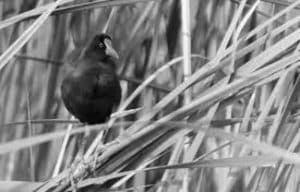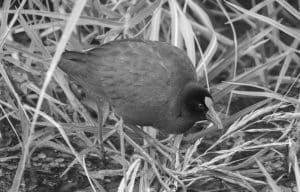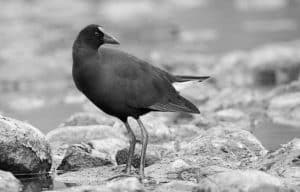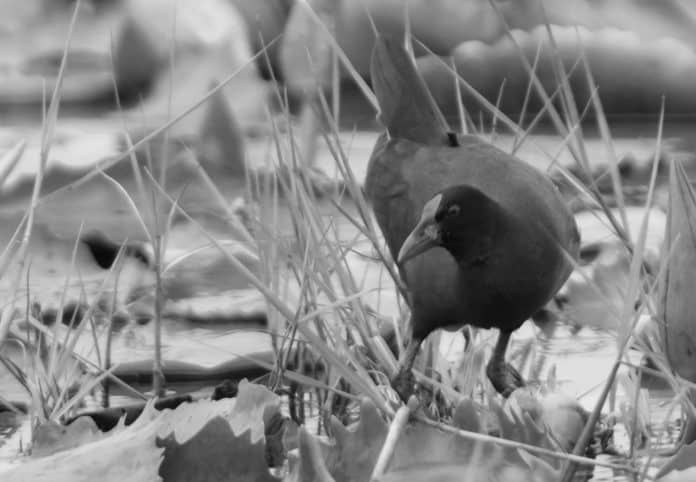Introduction to Allen’s Gallinule
Tanzania, a land teeming with natural wonders, is home to a variety of unique and fascinating wildlife. Among its many avian residents is the magnificent Allen’s Gallinule in Tanzania. This striking bird, known for its vibrant plumage and distinctive red shield on its forehead, is a true sentinel of the African waterside. In this article, we will delve into the habitat, behavior, and conservation efforts surrounding the Allen’s Gallinule in Tanzania.
Habitat of Allen’s Gallinule in Tanzania

The Allen’s Gallinule thrives in the lush wetlands and marshes of Tanzania. These serene and picturesque habitats provide the perfect environment for the bird to flourish. With their long toes and strong legs, Allen’s Gallinules are well adapted to navigate through the thick vegetation and shallow waters that characterize their habitat. From the shores of Lake Victoria to the sprawling wetlands of Selous Game Reserve, these birds can be found in abundance, adding beauty and life to their surroundings.
Behavior and Characteristics of Allen’s Gallinule
Allen’s Gallinules are highly social birds and are often found in small groups or pairs. They are known for their loud and distinctive calls that resonate across the wetlands. These calls serve multiple purposes, including territorial defense and communication within the group. The striking plumage of the Allen’s Gallinule is another notable feature. With its combination of deep blues, vibrant greens, and contrasting red shield, this bird is a true marvel to behold.
Importance of Allen’s Gallinule in the Ecosystem
The Allen’s Gallinule plays a crucial role in the ecosystem of Tanzania. As omnivores, they feed on a variety of plant matter, insects, and small aquatic creatures. By foraging in the wetlands, they help regulate populations of insects and other invertebrates, thereby maintaining a delicate balance within the ecosystem. Additionally, their presence serves as an indicator of the overall health of the wetland habitats. Monitoring the population and behaviors of Allen’s Gallinules can provide valuable insights into the ecological well-being of these areas.
Conservation Efforts for Allen’s Gallinule in Tanzania

Despite their importance, Allen’s Gallinules face numerous threats to their survival in Tanzania. Loss of habitat due to human activities, such as agriculture and urbanization, poses a significant risk to their population. Additionally, pollution and the introduction of invasive species further compound the challenges faced by these birds. Recognizing the need to protect this species, conservation organizations and local communities in Tanzania have joined forces to implement various initiatives. These include the establishment of protected areas, habitat restoration projects, and educational campaigns to raise awareness about the importance of preserving the Allen’s Gallinule and its habitat.
Birdwatching Locations for Spotting Allen’s Gallinule in Tanzania
For avid birdwatchers and nature enthusiasts, Tanzania offers a plethora of opportunities to observe the Allen’s Gallinule in its natural habitat. The Serengeti National Park, known for its vast savannahs and diverse wildlife, is a prime location for spotting these magnificent birds. The Ruaha National Park and the Mahale Mountains National Park are also renowned for their thriving populations of Allen’s Gallinules. Visitors to these locations can witness the bird’s graceful movements and vibrant colors, making for an unforgettable birdwatching experience.
Interesting Facts about Allen’s Gallinule
Did you know that the Allen’s Gallinule is not only a skilled swimmer but can also walk on floating vegetation? This unique ability allows them to navigate through their watery habitats with ease. Another fascinating fact is that the red shield on their forehead is thought to play a role in courtship displays, with males displaying their vibrant shield to attract potential mates. These intriguing facts only scratch the surface of the wonders that the Allen’s Gallinule holds.
Tips for Photographing Allen’s Gallinule in Tanzania

Capturing the beauty of the Allen’s Gallinule through photography is a rewarding endeavor. To ensure the best results, here are a few tips for photographing these birds in Tanzania:
- Patience is key: Allen’s Gallinules can be elusive and may require time to approach. Wait quietly and observe their behavior before attempting to capture an image.
- Use a telephoto lens: These birds are often found in the middle of wetlands or marshes. A telephoto lens will allow you to get close-up shots without disturbing their natural behavior.
- Focus on their unique features: The vibrant plumage and red shield are defining characteristics of the Allen’s Gallinule. Highlight these features in your photographs to showcase their beauty.
Challenges in Protecting Allen’s Gallinule in Tanzania
While efforts are being made to protect the Allen’s Gallinule in Tanzania, numerous challenges remain. The loss and degradation of wetland habitats continue to threaten their survival. The need for sustainable agricultural practices and responsible urban development is paramount to ensure the preservation of these vital ecosystems. Furthermore, community involvement and education are crucial in fostering a sense of stewardship towards the Allen’s Gallinule and its habitat.
Conclusion and Call to Action for Protecting Allen’s Gallinule
The Allen’s Gallinule is not just a bird, but a symbol of the remarkable biodiversity found in Tanzania. Its presence enriches the wetlands and serves as a reminder of the delicate balance within the ecosystem. As responsible stewards of our planet, it is our duty to protect and preserve these magnificent creatures and their habitats. By supporting conservation organizations, advocating for sustainable practices, and spreading awareness about the importance of the Allen’s Gallinule, we can ensure a brighter future for this sentinel of the African waterside.


































